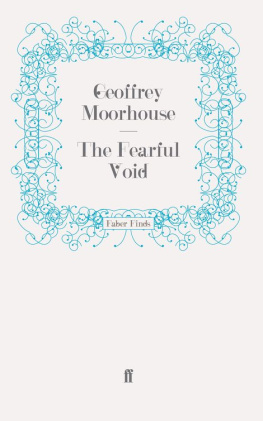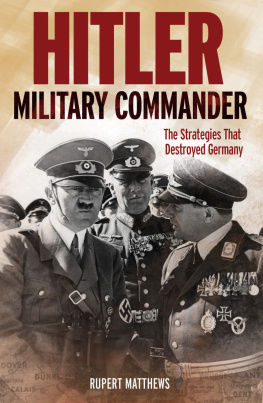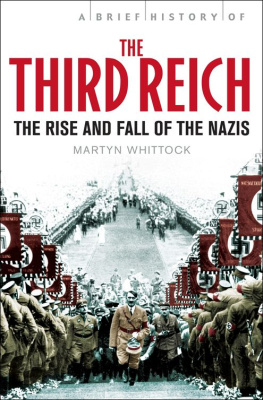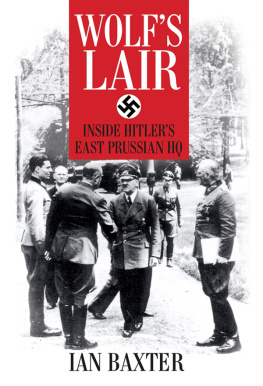Moorhouse - The Wolfs Lair Inside Hitlers Germany
Here you can read online Moorhouse - The Wolfs Lair Inside Hitlers Germany full text of the book (entire story) in english for free. Download pdf and epub, get meaning, cover and reviews about this ebook. year: 2012, publisher: Endeavour Press Ltd., genre: Detective and thriller. Description of the work, (preface) as well as reviews are available. Best literature library LitArk.com created for fans of good reading and offers a wide selection of genres:
Romance novel
Science fiction
Adventure
Detective
Science
History
Home and family
Prose
Art
Politics
Computer
Non-fiction
Religion
Business
Children
Humor
Choose a favorite category and find really read worthwhile books. Enjoy immersion in the world of imagination, feel the emotions of the characters or learn something new for yourself, make an fascinating discovery.

- Book:The Wolfs Lair Inside Hitlers Germany
- Author:
- Publisher:Endeavour Press Ltd.
- Genre:
- Year:2012
- Rating:4 / 5
- Favourites:Add to favourites
- Your mark:
- 80
- 1
- 2
- 3
- 4
- 5
The Wolfs Lair Inside Hitlers Germany: summary, description and annotation
We offer to read an annotation, description, summary or preface (depends on what the author of the book "The Wolfs Lair Inside Hitlers Germany" wrote himself). If you haven't found the necessary information about the book — write in the comments, we will try to find it.
The Wolfs Lair Inside Hitlers Germany — read online for free the complete book (whole text) full work
Below is the text of the book, divided by pages. System saving the place of the last page read, allows you to conveniently read the book "The Wolfs Lair Inside Hitlers Germany" online for free, without having to search again every time where you left off. Put a bookmark, and you can go to the page where you finished reading at any time.
Font size:
Interval:
Bookmark:
Roger Moorhouse
Roger Moorhouse 2012
Roger Moorhouse has asserted his rights under the Copyright, Design and Patents Act, 1988, to be identified as the author of this work.
First published 2012 by Endeavou r Press Ltd.
Introduction
Adolf Hitler and the Third Reich still fascinate us, and rightly so. The political and moral malevolence that the Nazis embodied fully deserves the constant and repeated scrutiny to which it is exposed. Yet, as someone who works in the field, it is frustratingly rare to read a genuinely novel approach, or fresh information. Of course, an important part of the historians job is the repackaging and re-evaluating of existing material, but there should be more to it than that. There should also be a duty to question the established narrative, point up contradictions and anomalies, expose the consensus to critical scrutiny. It is instructive to ask ourselves how often we learn something truly new about this most exhaustively-covered subject, or hear of an aspect that challenges our lazy, time-worn assumptions?
In this collection of articles and essays, I try to get away from the old tropes and the endless regurgitation that seems to typify the popular history of Nazi Germany. In the essays on Germania, Paul Ogorzow and Alfred Naujocks, for instance, I examine some of the more obscure aspects of the history of the Third Reich and, in the process, explain how they illustrate the wider story. As I am always keen to investigate the shades of grey in history, the essays on What They Knew, the Wannsee Conference and on Claus von Stauffenberg can be seen as correctives to the easy, binary labelling to which modern history writing often seems prone. The essay on the Wolfs Lair, meanwhile, which was written especially for this volume, is primarily the product of a long-held fascination with the site, but it also suggests the profound political influence that it may have had.
Much of the material presented here is the product directly or indirectly of research for my recent books: Killing Hitler (2006) and Berlin at War (2010), and those whose interest has been piqued by this volume might wish to seek out those two titles, both of which are available in digital and print form.
In addition, my understanding of the period has been hugely enriched by my involvement with the Hitlers Household series, produced over the last few years by Frontline Books, for which I wrote introductions. These volumes, each one a post-war memoir by a member of one of Hitlers entourage secretaries, valet, driver, pilot etc provide an invaluable insight into life at the epicentre of the Third Reich and into the character of Hitler himself. I am very grateful to Michael Leventhal of Frontline for suggesting my collaboration.
Many of these articles are reprints of pieces of mine that were first published by BBC History Magazine or History Today, and I am very grateful to the editors and publishers of those two excellent publications for their permission.
Hitler in the bunker said would-be assassin Claus von Stauffenberg, thats the real Hitler. He was right. Reinforced concrete seemed to follow Hitler like a Wagnerian leitmotiv ; his Reich was not only the largest builder of bunkers in history, it also perfected its art constructing shelters for its Fhrer , with almost all of his various residences and headquarters from Wolfsschlucht II at Margival in eastern France, to Wehrwolf near Vinnistya in Ukraine being generously equipped in that regard. The most famous of his field headquarters was the elaborate complex of bunkers, briefing rooms and blockhouses known as the Wolfsschanze , or Wolfs Lair, near Rastenburg in East Prussia. The Wolfsschanze would become Hitlers home from home; the headquarters that he would frequent more than any other during the war, spending more than 800 days there over the three years of its existence. With the exception of the Berghof above Berchtesgaden, no other location is so closely associated with Adolf Hitler.
The Wolfsschanze began life in the autumn of 1940, when Hitler asked his head of construction, Fritz Todt, to find a selection of sites from which he could oversee the invasion of the Soviet Union, planned for the following summer. Todt came back with a number of possibilities, but the most suitable location was near Grlitz, just to the east of the town of Rastenburg, in the German province of East Prussia. It was certainly a strategically well-chosen site. The region of Masuria in which it lay was sparsely populated with a landscape of gently rolling hills and dense, mixed forests. It was both out of the way and well-connected, with good local roads and a branch rail line providing an easy link to the mainline to Berlin. Also, mindful of a possible land attack from the east, the site at Grlitz was very well-protected, being directly to the west of a network of lakes and waterways, which would doubtless frustrate any Red Army advance.
Given the go-ahead, the site was swiftly developed and by the time that Hitler arrived to move in two days after the attack on the Soviet Union on 24 June 1941, it already boasted a number of substantial buildings, including garages, barrack blocks and an officers mess. It was Hitler himself who christened it the Wolfsschanze , explaining to one of his secretaries that, in common with many of his headquarters, it utilised the pseudonym Wolf that he had used during the political upheavals of the 1920s.
In the months and years that followed, the Wolfsschanze would scarcely stop growing and developing, with a programme of building continuing almost without interruption until the site was finally abandoned at the end of 1944. Existing installations would be constantly revamped and modernised, and new, improved designs constructed. As General Walter Warlimont noted: over the course of three years Wolfsschanze was turned into a fortress; the barbed-wire fences and the minefields became thicker and the concrete blocks stuck up like the superstructures of old-style cruisers. In fact, through the period of its occupation, the site consumed nearly 175,000 cubic metres of concrete; mixed, poured and shaped by a permanent workforce of around 4,600 labourers.
By the time that its final iteration was completed in the summer of 1944, Wolfsschanze was a virtual village, tucked away out of sight in the East Prussian forest. Almost completely self-sufficient, with its own electricity and water supply, sewers and heating plants, it contained around 200 buildings, including a communications bunker, sick bay, sauna, mess, cinema, tea-house and assorted other quarters, work rooms and shelters for its resident personnel. At its heart, of course, was the complex of bunkers and barrack blocks that made up Hitlers private quarters and those of his acolytes. The briefing rooms, often erroneously described in post-war literature as wooden huts, were solid brick-built structures often measuring over 30 metres in length. The bunkers, too, were enormous, especially after being revamped early in 1944. Constructed of reinforced concrete, they generally consisted of an inner core measuring around 6 metres in height containing a narrow corridor, off which a handful of small rooms could be accessed. Around that core, a massive concrete outer shell was added taking to total height up to 12 metres, with walls 6 metres thick and an additional 7 metres of foundations below ground. The result was accurately, if unflatteringly, described by Albert Speer: From the outside, he recalled, it looked like an ancient Egyptian tomb. It was actually nothing but a great windowless block of concrete, without direct ventilation, in cross section a building whose masses of concrete far exceeded the usable cubic feet of space. Working to this pattern, a few of the bunkers boasted additional features: Hitlers, for instance, had a single-storey kitchen appended to its western side, whilst Grings sported an anti-aircraft gun on its roof. The interiors were Spartan and functional, but nonetheless homely. Hitlers Secretary Christa Schroeder described her quarters in a letter:
Font size:
Interval:
Bookmark:
Similar books «The Wolfs Lair Inside Hitlers Germany»
Look at similar books to The Wolfs Lair Inside Hitlers Germany. We have selected literature similar in name and meaning in the hope of providing readers with more options to find new, interesting, not yet read works.
Discussion, reviews of the book The Wolfs Lair Inside Hitlers Germany and just readers' own opinions. Leave your comments, write what you think about the work, its meaning or the main characters. Specify what exactly you liked and what you didn't like, and why you think so.










